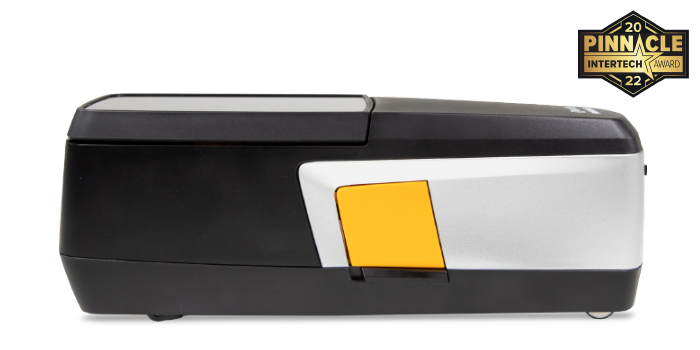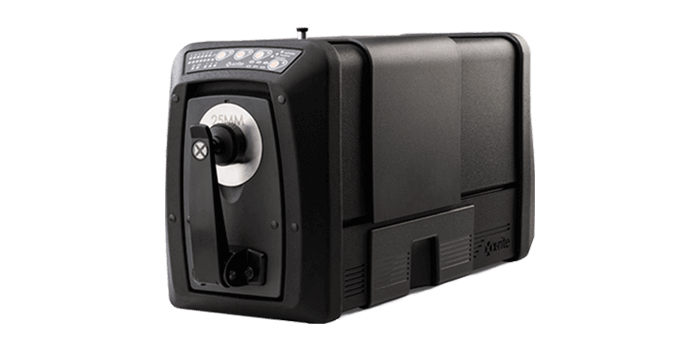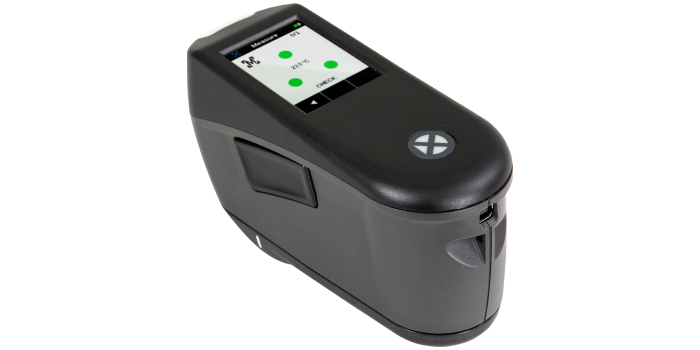 A spectrophotometer is a color measurement device used to capture and evaluate color. As part of a color control program, particularly in a global and distributed environment where components are manufactured in different locations and come together as an integral whole at assembly, brand owners, designers, suppliers, and manufacturers use spectrophotometers to specify and communicate color, and manufacturers use them to monitor color accuracy throughout production.
A spectrophotometer is a color measurement device used to capture and evaluate color. As part of a color control program, particularly in a global and distributed environment where components are manufactured in different locations and come together as an integral whole at assembly, brand owners, designers, suppliers, and manufacturers use spectrophotometers to specify and communicate color, and manufacturers use them to monitor color accuracy throughout production.
Every physical sample has its own reflectance, or the amount of light it reflects, and transmittance, or the amount of light it absorbs. A reflectance spectrophotometer shines a beam of light and measures the amount of light reflected from different wavelengths of the visible spectrum, while a transmission spectrophotometer measures how much light passes through the sample. Spectrophotometers can measure and provide quantitative analysis for just about anything, including liquids, plastics, paper, metal, fabric, and painted samples to verify color remains consistent from conception to delivery.
Watch our "What is a Spectrophotometer" video to learn more.
Spectrophotometer Types
There are three primary types of spectrophotometers. Your selection depends on application, desired functionality, and portability. Spectrophotometers come in a range of sizes, from portable devices to large benchtop instruments.
0º:45º (or 45º:0º) Spectrophotometer

The most common spectrophotometer, this instrument measures the wavelengths of light reflected at a fixed angle to the sample, usually 45˚. This type of spectrophotometer is compact and can exclude gloss to most closely replicate how the human eye sees color. It is commonly used for measuring color on smooth or matte surfaces.
The first number refers to the angle of illumination and the second number refers to the detection angle. With a 45:0 spectrophotometer, the light source shines at 45° from the perpendicular of the sample, and the detector receives reflected light at a 0° angle, or perpendicular to the surface of the object.
Sphere Spectrophotometer

Spherical spectrophotometers can measure light reflected at all angles to calculate color measurements that closely match what a human eye would see. They are commonly used for measuring color that has been applied to textured surfaces such as textiles, carpets and plastics, as well as shiny or mirror-like surfaces, including metallic inks, printing over foil, and other highly glossy surfaces. Some UV enabled sphere spectrophotometers can evaluate UV light over the ultraviolet range of wavelength (185 - 400 nm).
With a sphere spectrophotometer, the object to be measured is illuminated diffusely, or from all directions, and the detector receives the reflected light at an 8° angle from the surface of the measured object. This is known as “sphere geometry” because this instrument contains a sphere that provides diffuse illumination. In a sphere spectrophotometer, the inside of the sphere is lined with a highly reflective, low gloss, matte white substance used to project and diffuse the light, making it a near perfect white reflector. As the light beam strikes a point on the surface of the sphere, more than 99% of the light is reflected. At the same time, the matte finish of the sphere causes the light to be scattered randomly in all directions. This happens at every point on the surface and effectively causes light inside the sphere to seem to come from every direction at once, making the inside of the sphere the light source.
Multi-Angle Spectrophotometer
 A multi-angle spectrophotometer views the color of a sample as if it is being moved back and forth, just as you would twist a sample to see the color at various angles. Today’s multi-angle instruments are used for specially coated pigments and special effect colors with additives such as mica and pearlescent, such as nail polish and automotive coatings. These are typically used in the lab, on the production line, in QC operations and in the shipping area.
A multi-angle spectrophotometer views the color of a sample as if it is being moved back and forth, just as you would twist a sample to see the color at various angles. Today’s multi-angle instruments are used for specially coated pigments and special effect colors with additives such as mica and pearlescent, such as nail polish and automotive coatings. These are typically used in the lab, on the production line, in QC operations and in the shipping area.
Spectrophotometers come in both single beam and double beam configurations. A double beam spectrophotometer compares the light intensity between two light paths, one path containing a reference sample and the other the test sample. A single-beam spectrophotometer measures the relative light intensity of the beam before and after a test sample is inserted.
Benefits of an X-Rite Spectrophotometer
From cardboard packaging to laundry soap to carpeting and small plastic parts, X-Rite spectrophotometers help ensure that the color being produced matches the color that was originally specified the first time, every time, reducing waste and saving you time and money.
“We consider X-Rite to be an important partner in our ability to grow and to continue to exceed customer expectations. Our past experience with X-Rite and GretagMacBeth products has been excellent, and the new Ci7800 is no exception. Having this next-generation instrument as an integral part of our operation is vital to our ability to continue to move our color critical business forward.” - Jim Walsh, Technical Director at Penn Color
Spectrophotometer Categories
As the global leader in color trends, science and technology, we offer a full range of solutions that control color consistently and accurately from inspiration to final delivery. Whether you’re looking to specify, communicate, formulate, and measure color, we’ll help you get it right the first time, every time.
- Portable Spectrophotometers
Rugged, accurate, and comfortable in your hand or pocket, X-Rite portables measure color anywhere in your operation. Browse solutions for an array of surface geometries and materials.
- Benchtop Spectrophotometers
X-Rite benchtops are the preferred choice for laboratory-based operations that demand the highest level of color precision and control.
Learn More about Spectrophotometers
To learn how to select the right spectrophotometer based on the type of surface you are measuring, download our free whitepaper: Choosing the Right Spectrophotometer for Color Quality on any Surface.
이 맞춤형 페이지에서 참조한 제품
Featured Color Measurement Solutions
Find the X-Rite product that best fits your needs.
Mantis™ 비디오 타겟팅 및 Digital Loupe zoom 기술과 같은 특허받은 혁신적인 기능을 갖춘 eXact 2는 프린팅, 패키징 컨버터 및 잉크 공급업체를 위한 이상적인 선택입니다.
Ci7000 시리즈 적분구형 벤치탑 분광측색계는 전례 없는 트래킹과 반복 가능한 성능을 통해 색상을 측정, 관리 및 전달하기 위한 새로운 표준을 제시합니다.
X-Rite's portable multi-angle spectrophotometers combine color imaging with multi-angle technology to deliver precise color measurements on special effect paints and finishes.










